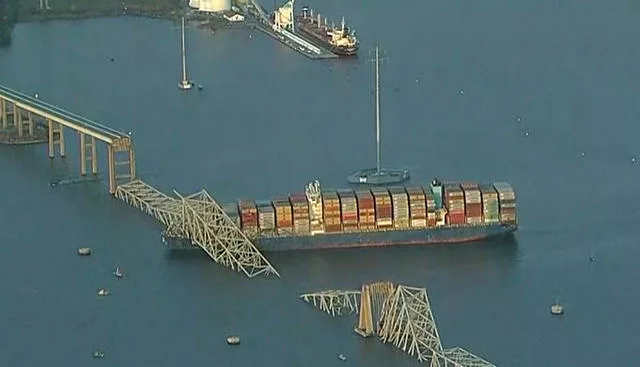In Baltimore, the crew of a cargo ship issued a distress call just before colliding with a bridge, prompting authorities to restrict traffic on the bridge, according to the governor of Maryland.
The collision occurred in the early hours of March 26, causing the bridge to break apart and fall into the river below. Numerous vehicles plunged into the cold waters, leading to a search and rescue operation.
Baltimore Fire Chief James Wallace reported that two individuals were pulled from the river beneath the Francis Scott Key Bridge, with one in serious condition. Wallace mentioned that there could potentially be seven more people to locate, though this number might change. It remains uncertain if the two rescued individuals were part of the initial count of seven.
The Port of Baltimore announced via Facebook that all vessel movements were halted until further notice, while truck operations continued at its marine terminals.
The cause of the cargo ship’s collision with the bridge remains unclear. This incident, described by one official as a “developing mass casualty event” in a major American city near Washington, happened well before the usual morning rush hour.
The ship struck one of the bridge’s supports, causing the structure to collapse and plunge into the water within seconds. Videos capturing the shocking event were shared on social media, showing the vessel ablaze with thick, black smoke emanating from it.
“Never would you think that you would see, physically see, the Key Bridge tumble down like that. It looked like something out of an action movie,” said Baltimore Mayor Brandon Scott, calling it “an unthinkable tragedy.”
SCARY MOMENT: Watch the moment the Francis Scott Key Bridge in Baltimore, Maryland collapsed. Authorities said at least seven people fell into the water — one person was taken to the hospital with serious injuries. 🙏🙏
— 7News DC (@7NewsDC) March 26, 2024
READ MORE: https://t.co/elMnlbfjk4 pic.twitter.com/7MmTnCpR41
Sonar readings have indicated the presence of vehicles in the water, where temperatures hovered around 47 degrees Fahrenheit during the early hours of March 26, according to data from a buoy monitored by the National Oceanic and Atmospheric Administration.
Earlier, Kevin Cartwright, the Baltimore Fire Department’s communications director, informed The Associated Press that multiple vehicles, including one as large as a tractor-trailer truck, were on the bridge when it collapsed. The incident occurred during the quiet hours of the night, reducing traffic compared to daytime when thousands of vehicles typically cross the bridge.
Cartwright described the collapse as a “developing mass casualty event,” although the exact number of individuals affected was initially unknown.
DEVELOPING: Closeup view of a ship losing power twice in Baltimore before hitting the bridge. The Francis Scott Key Bridge carries Interstate 695, and there are reports of cars in the water and the Coast Guard searching for at least 7 survivors. WATCHpic.twitter.com/Yk9SueFB1x
— Simon Ateba (@simonateba) March 26, 2024
He also noted that some cargo appeared to be hanging from the bridge, which spans the Patapsco River at the entrance to a bustling harbor leading to the Port of Baltimore, a significant shipping hub on the East Coast. Named after the author of “The Star-Spangled Banner,” the bridge was opened in 1977.
Maryland Governor Wes Moore declared a state of emergency and stated efforts were underway to deploy federal resources. While the FBI was present at the scene, there were no credible indications of terrorism. President Joe Biden received a briefing on the situation.
The Synergy Marine Group, which owns and operates the vessel named the Dali, confirmed that the ship collided with a bridge pillar around 1:30 a.m. while under the control of two pilots. The company assured that all crew members, including the pilots, were safe, with no reported injuries.
According to Marine Traffic data, the Dali was en route from Baltimore to Colombo, Sri Lanka, flying the flag of Singapore. The containership measures approximately 985 feet in length and 157 feet in width.
Danish shipping conglomerate Maersk disclosed that it had chartered the vessel, which was transporting cargo for its customers. There were no Maersk crew or personnel onboard. The collapse of the bridge caused a 2% decline in Maersk’s share price on the Nasdaq Copenhagen exchange during early Tuesday trading.
BREAKING: NBC News Special Report:
— NBC News (@NBCNews) March 26, 2024
Maryland Governor Wes Moore speaks after Francis Scott Key Bridge collapse in Baltimore.https://t.co/A4oXpwhiSM





